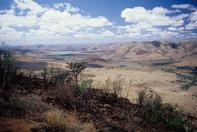Rustenburg Area
The first Voortrekker farmers settled in the Rustenburg area in 1841, following the defeat of Mzilikazi, the Ndebele leader and his army of impi’s, during a punitive expedition two years earlier.

The third-oldest town north of the Vaal River, the settlement was proclaimed in 1851 and named Rustenburg, meaning 'town of rest'. Its growth accelerated after Dr Hans Merensky discovered a seam of platinum-bearing rock near here in 1925.
South African War
The Magaliesberg has featured prominently in many vital chapters of this country's past: early hominid remains from about 2,5 million years ago have been unearthed in the nearby dolomite caves of Kromdraai and Sterkfontein, and it can therefore be assumed that the earliest Homo sapiens lived and hunted here too. During the time of the Mfecane wars local clans took refuge from Mzilikazi's marauding impi’s in the deep gorges of the Magaliesberg; the range is named after Mohale, the chief of one of these clans.
Some of the final, decisive battles of the South African War were fought in and around the mountains near Hekpoort. During the war's guerilla phase, the maze of mountains provided a conduit by which the Boer forces moved through occupied territory. British blockhouses can still be seen guarding the approaches to some of the well-known passes.
Rustenburg Platinum Mines
Back in the day, John P.H. Acocks was employed by the Dept of Agriculture, and what turned out to be his life's work was a classification of South Africa into 'veld types' specifying the main species in each. He also identified the long and short-term effects of man's influence on the country's natural vegetation. In the course of his work Acocks travelled hundreds of thousands of (mostly dusty) kilometres. His book, Veld Types of South Africa, was first published in 1953, and since then it has become the most frequently quoted scientific text in the country.
As one gains height, Rustenburg's suburbia comes into view, with the industry of Rustenburg Platinum Mines dominating the town. Platinum is the most important mineral extracted from the laval deposits of the Bushveld Igneous Complex geological system. These lavas were poured out onto a sandstone bed of the Transvaal Supergroup about 600 million years ago.
Such was the weight of this extrusion that it compressed the sandstones, metamorphosing the contact rocks and lifting them around its perimeter. It is as if a giant foot had stepped into the middle of the Transvaal, pushing up the surrounding rocks like uptilted pavement blocks.
This 'popping up' effect formed the ranges of Magaliesberg, Waterberg and the Eastern Transvaal escarpment. The kloofs within the Magaliesberg are stress fractures caused during the formation of these mountains.